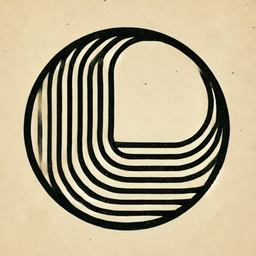How AI Journaling Can Read Your Patterns, Coach Your Habits, and Keep You Human
A deep guide to modern journaling with AI: how AI journaling apps work, what’s new in 2025, how to choose the best AI journaling apps 2025, and a step-by-step workflow to turn raw entries into insight while staying private and human.

Why AI Belongs in Your Journal
Journaling has always been simple: pen, paper, mind. It still is.
The shift is what happens after you write. An AI journaling app can read at scale what you can’t hold in working memory—moods across months, recurring triggers, the gap between values and behavior. That doesn’t replace you. It extends your attention.
You write. AI surfaces patterns. You decide.
In 2023–2024, a Youtuber @ThatJournalingGuy trained a notebook assistant on more than 600 personal entries. It reflected hard truths he'd struggled to articulate: the tug-of-war between ideals and impulses, how family scripts shaped his relationships, which goals repeated without progress, and the language he used when he was kind to myself versus brutal.
It felt unsettling and liberating. Mostly, it was useful.
The question isn’t “Will AI replace journaling?” It’s “How do we journal better when a second mind can help us see what we miss?”
What an AI Journaling App Actually Does
You can think in four layers:
1) Capture thoughts
- Frictionless input: text, voice, photo, quick bullets.
- Context: timestamp, location (optional), tags, mood pickers.
- Import: PDFs, old notes, email digests, transcripts.
2) Understand, Identify, Reason
- Personalized prompts: Follow-ups based on your history, not generic lists.
- Sentiment analysis: Trends in emotion and tone across days, weeks, months.
- Entity and theme extraction: People, projects, places, and recurring topics.
- Cognitive patterns: Catastrophizing, black-and-white thinking, avoidance flags.
- Goal/behavior detection: Mentions of habits, streaks, and obstacles.
3) Reflect & Provide Perspectives
- Weekly reviews: Auto-summaries with “wins, frictions, lessons.”
- Narrative mirrors: “Here’s how you describe yourself when you’re hopeful vs. depleted.”
- Theme timelines: “Confidence” across the last 90 days; “sleep” vs. “mood.”
- Projection checks: What you dislike in others vs. what you fear in yourself.
4) Coach
- Micro-experiments: One-week challenges derived from your stumbling blocks.
- If-then nudges: “If you mention procrastination + guilt, prompt a five-minute start.”
- Actionable reframes: Thought → evidence → alternative → next step.
- Habit scaffolds: Tiny next actions, deadlines, and accountability check-ins.
Apps like Life Note help you with all four of the layers. You write as usual. The app runs these layers in the background. Insight shows up in plain language.
Case Study: Training NotebookLM on 600 Personal Entries
When Google released NotebookLM, it wasn’t marketed as a self-therapy tool — more like an AI note assistant. But the experiment that followed turned it into something much deeper.
@ThatJournalingGuy exported over 600 journal entries from Day One, spanning 2023–2024, complete with timestamps and photos. Then he uploaded them into NotebookLM alongside two years of time-tracking reports. The model now had access to the entire arc of my emotional and creative life: breakups, ambitions, burnout, recoveries.
When he asked it to analyze recurring themes, it cited specific entries and surfaced truths he hadn’t noticed:
- A fear of intimacy masked by romantic pursuit.
- A habit of seeking external validation to fuel motivation.
- A pattern of describing happiness as freedom, love, and self-improvement—but also repeatedly failing to honor those ideals.
Each conclusion came with clickable citations showing the journal entries it was derived from. Reading that list felt invasive and eerily precise — like watching your subconscious transcribed into bullet points. His first response was shock, then relief. The AI had no agenda, no judgment; it was just showing me what I’d written, arranged by pattern.
The emotional impact was strange: fear mixed with validation. For the first time, my entire inner narrative had been mirrored back at scale. It revealed blind spots he couldn’t have found entry by entry, because human memory can’t hold that much context at once. NotebookLM acted less like a therapist and more like a forensic analyst of my inner world — direct, unemotional, and startlingly clear.
The insight? AI isn’t replacing reflection; it’s extending it. Where traditional journaling captures moments, AI connects them.
A Safe, Powerful Workflow: From 600 Entries to Clarity
Use this regardless of which AI journaling app you pick.
Step 1: Ingest
- Import your last 6–24 months of entries (or start today and let it build).
- Tag a small sample set with mood, energy, and context to help the model calibrate.
- Decide what’s private. Redact names or sensitive identifiers if needed.
Step 2: Baseline Reflect
Ask the assistant to produce:
- A neutral life map: top five themes, top five drains, top five sources of joy.
- A language snapshot: your most frequent self-descriptors on good and bad days.
- A trigger table: situations, emotions, results, and recovery time.
Step 3: Pattern Audit
Run three lenses:
- Time: Which topics spike on weekdays vs. weekends? Morning vs. night?
- People: How do tone and mood shift when certain names appear?
- Projects: Which efforts show up for months with no movement?
Step 4: Design Micro-Experiments
For each friction, define:
- One constraint: “No phone in bedroom.”
- One behavior: “Five-minute start on the hard task.”
- One measure: “Was it easier to begin? Y/N.”
- One review cadence: Weekly.
Step 5: Weekly Review, But Short
Ask for a one-page report:
- Wins: Specific, not vague.
- Friction: What blocked progress.
- Lesson: A sentence you could teach a friend.
- Next tiny step: Concrete and calendar-linked.
Step 6: Privacy Hygiene
- Enable end-to-end encryption.
- Export plain-text backups monthly.
- Keep a “paper only” notebook for the few entries you never want analyzed.
- Turn off any sharing you don’t need. Your journal is a sanctuary first.
A Model-Friendly Way to Write (So AI Helps You More)
- One entry, one idea. Force clarity.
- Label feelings + facts. Makes it easy to separate story from reality.
- Ask questions. The assistant can answer only what you ask.
- Note outcomes. “Tried X, felt Y, result Z.” That’s the gold for coaching.
- Mark wins. You need data for confidence, too.
The Human Concerns You Shouldn’t Ignore
“Will it still feel like my journal?”
Yes, if you put your voice first. Keep some entries unprocessed. Use AI for synthesis, not authorship.
“Do I lose privacy?”
Only if you hand it away. Choose private storage, export regularly, and keep a redaction habit.
“Will I over-rely on prompts?”
Set a rule: write freehand first, then ask for reflections. The human goes before the machine.
“Can it misread me?”
Sometimes. That’s why citations matter. Inspect, correct, and teach the model your preferences over time.
An “AI-Generated Podcast” Reflection
After training the model, ThatJournalingGuy took the experiment one step further — turning his journal into an AI-generated podcast to hear what his inner world might sound like.
The result was uncanny: two synthetic narrators analyzed a year of his life like film critics breaking down a character study. They spoke about love, family tension, ambition, and self-doubt as if he were both the subject and the storyteller. One voice observed, “It’s like he’s trying to reconcile his actions with his heart — the whole human experience in miniature.”
The dialogue was unnervingly insightful. The AI highlighted moments when he considered a career shift into AI development, framing it not as escape but as a search for purpose. It identified ambition laced with vulnerability, drive tempered by doubt — even teased him for overusing the word “existential.”
Beneath the humor lay a profound question:
Is AI the future of self-reflection, or are we surrendering the very essence that makes journaling human?
What the experiment revealed was not imitation, but illumination. The AI could mirror his life without bias, showing what emotions, patterns, and contradictions sound like when stripped of human defensiveness.
For the first time, journaling became audible introspection — not to replace therapy or writing, but to extend awareness into sound. This is where AI-assisted reflection begins to evolve: tools that don’t just help people write about themselves, but help them listen to themselves with unprecedented clarity.
A Concrete 7-Day Starter Plan
Day 1 — Import & Setup
Turn on encryption. Import recent entries. Create a tag set: #work, #health, #love, #money, #creative, #sleep.
Day 2 — Baseline Report
Ask for top themes, drains, and energy sources over the last month.
Day 3 — Anxiety Protocol
Use the two-column “facts vs. story” template. Get a one-line reframe and a two-minute action.
Day 4 — Decision Page
Feed one decision. Get options, reversibility, regret test, and an “easy mode” plan.
Day 5 — Energy Audit
Request a 30-day energy chart and pick two rules to add and two to stop.
Day 6 — Relationship Clarity
Analyze tone on entries that include a key person. Draft one honest conversation.
Day 7 — Weekly Review
Generate a one-page digest: wins, frictions, lessons, next steps. Schedule the first step.
Repeat. Insight compounds.
Practical Ways to Use AI Journaling Tonight
1. Calm Your Anxiety Loop
Write down what actually happened (the “first arrow”).
Then ask AI to name the story your mind added (the “second arrow”).
Finish with: “Give me one short reframe and one simple action I can take.”
2. Make a Decision Grid
Prompt: “List my options, costs, which are reversible, and what I’d regret most not doing. Then show me what it would look like if this were easy.”
You’ll get a one-page plan that turns confusion into clarity.
3. Track Your Energy
Ask AI to review your last 30 days of entries and mark moments that gave or drained energy.
Then create two rules to add more energy and two to stop leaks.
Check once a week and adjust.
4. See Relationship Patterns
Ask AI to analyze your tone when you write about someone.
Notice recurring unmet needs or emotional bids.
Then draft one honest conversation with empathy and precision.
5. Build Creative Momentum
Have AI pull idea fragments from past entries.
Sort them by theme.
Pick three and finish them this week — all in one sitting each.
How to Choose the Best AI Journaling Apps 2025 (Decision Checklist)
Score contenders 0–3 on each:
Data Ownership
- End-to-end encryption
- Local export (markdown/JSON)
- Bring-your-own-key or at least clear key policy
Capture Experience
- Fast voice-to-text with punctuation
- Mobile + desktop parity
- Low-friction tags and mood pickers
Insight Quality
- Specific, cited summaries
- Useful trends, not pretty charts
- Prompting that sounds like you, not a robot
Habit and Review
- Tiny actions you can schedule
- Weekly digest you’ll actually read
- Streaks that don’t shame you
A high-scoring app respects your autonomy, speeds capture, and returns insight with receipts.
How Life Note Fits In

Most people fail at “journaling prompts for anxiety” for two reasons:
- They don’t know what to write today.
- They don’t see progress, so they stop.
Life Note is designed to support and expand your personal growth journey. With its AI-powered journaling features, it allows you to delve into your unconscious patterns and emotional themes in a way that traditional journaling often can't. By engaging with mentors inspired by figures like Carl Jung and Brené Brown, you can uncover fresh perspectives and deepen your self-awareness. The platform's advanced memory system helps you identify recurring patterns and track your emotional progress over time, making it an excellent companion for shadow work.
"I've encouraged clients and students for decades to keep journals as one of the best tools for self-awareness. When AI journaling apps began appearing, I tried several. Most gave sycophantic responses. That changed when I found Life Note. It strikes a rare balance - offering support with gentle nudges and thoughtful invitations to reflect. Having the voices of luminaries from different fields comment on my writing has been a game changer - deepening the experience and helping me gain insights beyond my own words. I'm genuinely excited about the future of Life Note, and I see AI journaling not as a replacement for therapy, but as a powerful tool to complement it."
— Sergio Rodriguez Castillo, Licensed Therapist & College Professor
For those already in therapy, Life Note serves as a perfect complement. It helps you process what you’ve discussed in sessions, explore themes between appointments, and maintain a sense of continuity in your growth. The personalized weekly reflection letters are especially useful for spotting patterns and progress that might otherwise go unnoticed.
TL;DR
- Journaling with AI = your writing + pattern detection + feedback loops.
- Core wins: personalized prompts, sentiment trends, behavior patterns, and habit coaching.
- 2025 trendline: on-device models, encrypted sync, timeline visualizations, and voice-first capture.
- Use a privacy-first setup, export routinely, and keep “human time” on paper when needed.
- Try the “Ingest → Reflect → Coach → Act” loop below to turn 600+ entries into a personal growth engine.
FAQs
What is an AI journaling app?
A private notebook with a built-in analyst. It captures entries, detects patterns, summarizes weeks, and suggests small next steps—all from your writing.
Is this safe for sensitive entries?
Yes, if you choose tools with end-to-end encryption, on-device or private compute, and clean exports. Keep a “paper-only” lane for topics you never want analyzed.
Will AI change my voice?
Not if you don’t let it. Write first. Use AI to mirror, not to author. Decline auto-rewrite features if they feel off.
How soon until I see value?
Usually within a week. The first weekly digest surfaces wins, frictions, and one step you can take. Depth grows with more entries.
Can it help clinical issues?
It can support reflection and habit change. It is not a therapist. Seek professional care for acute symptoms, trauma processing, or crisis support.
What’s the smartest way to start?
Pick one workflow: Weekly Review. Keep it to one page. Build from there.
Which are the best AI journaling apps 2025?
The “best” is the one that meets your privacy bar, fits your capture style, cites its summaries, and delivers one useful weekly action. Use the checklist above to evaluate candidates. Life Note is an app that's been made to meet all the standards.
A Note on Humanity
AI can map your patterns. It cannot decide who you want to be. That part stays yours. Keep a pen. Keep a page that never gets analyzed. Let the machine do math; you do meaning.
If you’re building this practice into your life, start small. One honest entry a day. One truthful review a week. One tiny step forward. That’s how a private notebook becomes a personal flywheel.
Pick up the pen tonight. Ask a better question. Then let your future self read the answer.
Explore More






